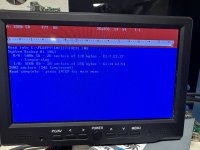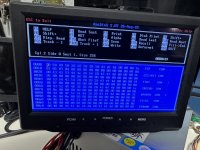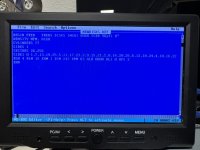sponaugle
Member
I'm working on restoring an old IMSAI 8080 I recently acquired. The system itself looks to have been sitting for the last 30 years or so. I removed everything and checked the power supply first, which measured perfect. I installed the cpu card and a ram card and the system came up without any problems. I was able to enter some code via the front panel which executed correctly.
The system had some other cards that look to have been 'stored' inside the unit. There were three floppy disk controller cards, plus two SIO cards and a 64K DRAM card along side a 64K SRAM card.
I also got two 8 inch floppy disk drives, which were a bit rough. One has a broken door latch, and both were pretty dirty. They were in an 'enclosure' but without the lid, so they also had what looked like 30 years of dust! I took the better drive of the two apart and cleaned it, cleaned the heads, lubed a few places, and checked the power supply (these drives use +24V, +5, and -12, plus 120V for the spindle motor).
I connected the drive up to a PC using the new TexElec 4 floppy controller and didn't have any problems getting it working. It is a single sided drive, and I was able to read and write a new single sided disk (77 tracks).
I have about 40 8" disks from the original IMSAI system that I'd like to be able to read. Using IMD I was able to scan and read the disks, but I'm curious about the format.

Most of them (including the ones labeled System Backup) show up as 77 tracks, with track 0 being 500k MFM, Single Density, 26 sectors/track, 128 bytes/sector, while the rest of the tracks (1-76) are 500k MFM, Double Density, 26 sectors/track, 256 bytes/sector.
A small portion of them show up as track 0 being 500k MFM, Single Density, 26 sectors/track, 128 bytes/sector, while the rest of the tracks (1-76) are 500k MFM, Double Density, 15 sectors/track, 512 bytes/sector.
Is it common that in 8" CPM formats the first track is single density, while the rest of the tracks are double density? I could not find any formats in 22DISK that looked like this. Any other tools that I should try using to be able to read this format?

The system had some other cards that look to have been 'stored' inside the unit. There were three floppy disk controller cards, plus two SIO cards and a 64K DRAM card along side a 64K SRAM card.
I also got two 8 inch floppy disk drives, which were a bit rough. One has a broken door latch, and both were pretty dirty. They were in an 'enclosure' but without the lid, so they also had what looked like 30 years of dust! I took the better drive of the two apart and cleaned it, cleaned the heads, lubed a few places, and checked the power supply (these drives use +24V, +5, and -12, plus 120V for the spindle motor).
I connected the drive up to a PC using the new TexElec 4 floppy controller and didn't have any problems getting it working. It is a single sided drive, and I was able to read and write a new single sided disk (77 tracks).
I have about 40 8" disks from the original IMSAI system that I'd like to be able to read. Using IMD I was able to scan and read the disks, but I'm curious about the format.

Most of them (including the ones labeled System Backup) show up as 77 tracks, with track 0 being 500k MFM, Single Density, 26 sectors/track, 128 bytes/sector, while the rest of the tracks (1-76) are 500k MFM, Double Density, 26 sectors/track, 256 bytes/sector.
A small portion of them show up as track 0 being 500k MFM, Single Density, 26 sectors/track, 128 bytes/sector, while the rest of the tracks (1-76) are 500k MFM, Double Density, 15 sectors/track, 512 bytes/sector.
Is it common that in 8" CPM formats the first track is single density, while the rest of the tracks are double density? I could not find any formats in 22DISK that looked like this. Any other tools that I should try using to be able to read this format?







